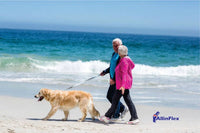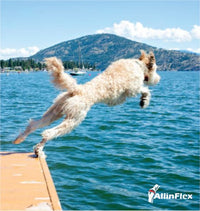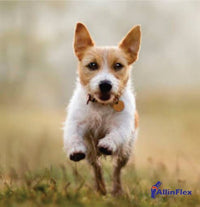Exercise guidelines for Puppies
Saskia OstermeierIt's not advised to take a puppy at the age of 6 months on long walks.
Puppies bones, joints and muscles are still developing and not yet fully formed. Overexerting them on long walks could cause strain and injury to the pup's growing bones and joints, particularly the growth plates.
Here are some exercise guidelines for puppy owners:
- Start with short, low intensity walks or play sessions, even though your pup may seem to have a lot of energy, gradually increase the length and intensity over time as your puppy grows and develops. The pup will grow in confidence and enjoy the walks.
- Choose activities that are appropriate for your puppy's breed and age. Some breeds enjoy running or swimming, while others prefer playing fetch or going on leisure walks.
- Puppies bones and joints are still in a developing stage and can be easily injured by high-impact activities like jumping out of the car and running on hard surfaces.
- If during the exercise the pup shows signs of fatigue, overheating, or any other discomfort stop and offer the pup water and let the pup rest.
- Puppies need mental stimulation and socialise with other people besides their own human family as well as meet other dogs to grow confidence.
Puppy Exercise Guide by age:
1 month old pup | 5 minutes of exercise | twice a day
2 month old pup | 10 minutes of exercise | twice a day
3 month old pup | 15 minutes of exercise | twice a day
4 month old pup | 20 minutes of exercise | twice a day
5 month old pup | 25 minutes of exercise | twice a day
6 month old pup | 30 minutes of exercise | twice a day
7 month old pup | 35 minutes of exercise | twice a day
8 month old pup | 40 minutes of exercise | twice a day
Because puppies have a lot of energy, try not to be tempted to over tire them.
In the developing bones and joints of puppies the growth plates are delicate.
You probably have heard that puppies have growth plates but what are they exactly? New bone is formed on growth plates. When the growth plates are 'open' they are active creating new bone cells and when they are 'close' the new bone formation sets into strong bone. When the pups growth plates are 'open', the pups bones and joints are delicate and can be easily damaged.
A puppy's life is full of curiosity and new experiences, and exercising is one such thrilling adventure. As they journey through the stages of puppyhood, we must make sure they do so in the safest, most beneficial way possible. This involves making sure their exercise routines are just as well-balanced and developmentally suitable as their diets.
Let's talk more about the concept of "growth plates."
They are soft areas that reside at the ends of the long bones in puppies and young dogs. They contain rapidly dividing cells that allow bones to become longer until the end of puberty. As your puppy reaches full size, these plates close and transform into solid bone.
This process is completed at a different time for each breed and size of dog, but typically by the age of 18 months, most dogs' growth plates are closed.
During the time when the growth plates are still open, vigorous activity or injuries can cause them to break or fracture, resulting in improper bone development.
The injury to the growth plate can lead to bone deformity, lameness, or an incorrect gait. This is why it's so important not to over-exercise your pup, especially on hard surfaces.
While the above guide provides an age-appropriate exercise time for puppies, remember that every puppy is unique.
They grow at different rates, and their need for rest, play, and exercise will vary. Therefore, always observe your pup and adapt the exercise to their pace, their breed characteristics, and individual needs.
Some puppies might need a bit more rest, while others might be ready for a bit more play. Let your puppy be the judge!
Additionally, always make sure to warm up your puppy before any exercise and cool down afterwards. Warming up can be as simple as a slow walk or some gentle play, gradually increasing in intensity. Cooling down is equally important, as it helps to slow the heartbeat and breathing rate and decreases the risk of muscle injuries.
Finally, never underestimate the power of mental stimulation!
Training, socializing, and problem-solving activities can tire out your puppy just as much as physical exercise. Incorporating obedience training, introducing new objects or sounds, or interactive toys into your puppy's day can be a great way to tire them out and keep their brain sharp.
Being a puppy owner is an exciting journey of growth and discovery, for both you and your furry friend. Remember, the goal is to raise a happy, healthy dog, and proper exercise during puppyhood lays a strong foundation for a lifetime of good health.
And remember: always consult your veterinarian if you have concerns about your puppy's growth or exercise routine. They can provide breed-specific advice and identify any potential issues early.






